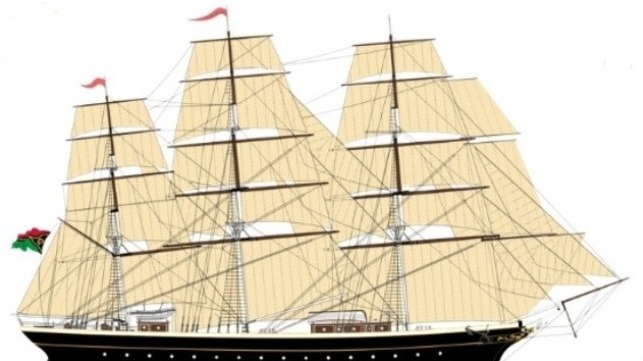Dutch Company Proposes Sailing Ships as Emissions Solution

A Dutch cargo company working to develop a fleet of zero-emission sail-powered cargo ships has released a Life Cycle Analysis (LCA), which examines the impact sail cargo ships could have on the transport industry. The study was carried out by EcoClipper’s specialists and environmental scientist Andrew Simons (Co-founder of 3SP and Sailink) and shows that the environmental and human health impact of the EcoClipper500 is significantly lower than conventional shipping methods.
EcoClipper was founded in 2018 and is developing a fleet of sailing ships which it proposed to sail on four shipping lines with fixed schedules, creating a new shipping logistics system for sail cargo vessels. The prototype design is for a vessel nearly 200 feet long powered entirely by just over 20 sails creating 976 m2 of sail area on three masts. According to the company, the vessel would be able to carry 500 tons of cargo along with a crew of 12, 36 trainees and up to 12 passengers.
The concept calls for three regular routes to be established starting with the Atlantic sailing from the English Channel to the United States and the Caribbean. The Pacific route would sail from California to China and Japan and finally the most ambitious is a traditional route sailing around the world using the westerly wind patterns. They would sail from Europe to South America and South Africa, across the Indian Ocean to Australia before heading north to Asia. The route would continue across the Pacific to California before turning south to round South America heading to the United States before returning to Europe.
“By commissioning an LCA at such an early stage, the EcoClipper project has not only acknowledged the environmental consequences of human actions but enabled life cycle considerations to be factored into the design process whilst supporting investors and eventually customers in their decisions to participate. This makes for very progressive business sense,” says Andrew Simons, author of the study.
The LCA confirms that the expected carbon emissions from the EcoClipper500, along with its construction, maintenance methods, and life cycle, could represent a very appealing alternative for transporting goods as well as for traveling via sailing ship. For instance, an EcoClipper vessel will produce 80 percent fewer emissions than a containership over its lifetime, when both are carrying the same cargo tonnage. According to the report, this is predominantly due to the use of renewable energy on an EcoClipper ship, rather than Heavy Fuel Oil. The study also describes how the chosen design of the vessel along with its operation management will contribute to an environmentally friendly, low emission life cycle.

that matters most
Get the latest maritime news delivered to your inbox daily.
“As a sustainable company striving to revolutionize shipping into a sustainable industry, it is very important for EcoClipper to have information on environmental emissions and impacts of its first vessel: the EcoClipper500. This way, EcoClipper specialists can find a way of reducing them as much as possible while still accomplishing our purposes,” says Jorne Langelaan, founder and CEO of EcoClipper.
With this research, EcoClipper says that it proved that the most sustainable way to transport cargo and passengers is using a traditional design of vessels, the Clipper ship, with square-rig sails. EcoClipper reports that it is currently examining the financial market to build the first ship.
